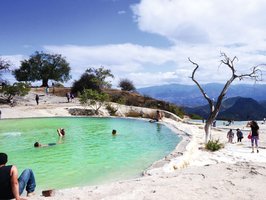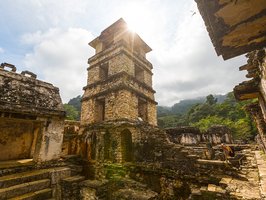Mexico Travel Information
Mexico, the birthplace of some of the most exciting culture and traditions in the world, is truly a one-of-a-kind destination! Mexico offers a wide range of awesome attractions, breath-taking beaches and a rich cultural heritage that plays its part in attracting tourists all year round. This magnificent country has a little something for everyone, from natural landscapes, vivacious locals and a history that will inspire even the most steadfast tourists. If you have decided to visit Mexico and experience this amazing country’s well-loved attractions, then read all about the entry and exit requirements below.
Here you can find tip for your entry, about the currency, the best time to travel and about the vaccination you need. Get entchanted by the history of the Mayas and travel with us to Mexico.
Entry & Exit
Tourists visiting Mexico will require a valid passport with an expiration date of at least 6 months from the date of departure. Tourists will also need to provide proof of a return ticket, a visa (if required) and proof of sufficient funds. Visitors may also be asked to provide a valid health certificate with records of recent vaccinations and illnesses.
UK, US and Canadian citizens as well as tourists with a valid US or Canadian visa do not require a tourist visa in order to visit Mexico for up to 180 days.
The following nationalities do not need a visa in order to visit Mexico for a period of up to 180 days for recreational purposes only:
- United Kingdom
- United States
- South Africa
- Countries of the European Union
- Canada
Tourists travelling with one of the following valid passport or visa will not require a tourist visa:
- United States
- United Kingdom
- Japan
- Northern Island
- Schengen Visa
Like all countries, Mexico has the following import and export rules. Failure to abide by these regulations may result in severe penalties, fines and possible imprisonment. Tourists should always find out the rules and regulations of the customs officials in the country they are visiting to avoid any confusion upon their arrival.
Tourists over the age of 18 are permitted to carry the following items into Mexico:
- 200 cigarettes, 5o cigars or 200 grams of pipe tobacco
- 3 litres of wine or alcoholic beverages
- Perfume and cologne for personal use only (reasonable quantities)
- A camera or audio-visual recorder
- 12 rolls of film for non-digital cameras
- Goods up to the value of US$300
The following items are strictly prohibited:
- Un-canned food products as well as canned pork and pork derivatives.
- Plants, seeds, fruits, vegetables, roots, stems, flowers or any parts of a plant thereof. Stones, soil or any other earth products are prohibited.
- Firearms and ammunition unless a permit is obtained from the Secretary of National Defence.
- Local currency of more than US$10 000 must be declared upon arrival.
An Airport Embarkation Tax of US$18-29 per passengerwill be charged for travellers over the age of 2 years old.This is payable at the airport of departure, if not already included in airfare.
In order to ensure a safe and healthy trip, tourists are advised to visit a medical practitioner at least 4-6 weeks prior to their departure to obtain a full medical. All vaccinations should be up to date and a health certificate is recommended.
The following vaccinations are strongly recommended for tourists travelling to Mexico:
- Diphtheria
- Hepatitis A
- Rabies – Sometimes recommended for younger children
- Tetanus
- Typhoid
Only bottled water or water marked sterilised and safe to drink should be used for drinking and teeth brushing. Milk may not be pasteurised, so powdered or tinned milk is preferable, but most hotels will offer this as a standard. Fruit should be washed with sterilised water and peeled prior to being eaten and vegetables, meat and seafood should be well-cooked.
Tourists should keep skin-health in mind, and use a strong sun-block at all times during the day to avoid sun burn. It is advisable to keep hydrated and be sensible when spending the day in the sun.
Travel Facts about Mexico
Mexico offers two climates depending on the chosen region. Coastal regions have a hot and humid climate, making summer escapes to Mexico ideal. But even though the temperatures are lovely and hot, there is the risk that the hurricane season provides from June until October and sometimes November. In Mexico’s inland regions the weather is warm and comfortable, similar to a year-long spring season. It does however cool down from December until around the end of March.
From warm and dry to slightly crisper spring time temperatures or even the humid and hot peaks, Mexico has a temperature for everyone. Summer temperatures can reach an average of 28◦C while the weather seldom drops below 23◦C.
Mexico’s central time zone is UTC/GMT – 06:00 out of daylight saving time. Daylight savings time begins around the first week in April and ends towards the end of October usually. During daylight savings time, Mexico falls under the UTC/GMT -05:00 time zone.
Mexico’s official currency is the Mexican Peso (MXN). The US Dollar is accepted in some regions but can sometimes make shopping more expensive, so it is recommended that tourists use Pesos. Travellers Cheques and credit/debit cards from major banks are also accepted. ATM's are available in Mexico and tourists are advised to make use of these, as opposed to using US Dollars to pay for their items.
High speed internet is quite easily accessible in Mexico. Large tourist regions offer internet services in most restaurants, bars and cafés and almost every tourist resort and upmarket hotel offers internet access. Internet cafés are also in abundance and are relatively inexpensive.
Mexico’s electrical outlets are similar to those used in the US and Canada. The country makes use of a 120V; 60Hz power current, which will not require an adaptor or transformer for tourists travelling from the United States. Tourists travelling from other regions are advised to bring an adaptor, as well as a voltage transformer.
In order to phone Mexico from outside of the country, callers will need to dial 011 52 1 + the 10 digit number. For cell calls within Mexico, the caller will need to dial 045 and then the 10 digit cell number. Hotels, resorts and payphones should have a list of country codes to help callers dial international numbers correctly. +52 is Mexico’s official dialling code.
Mexico’s national emergency number is 911. It is recommended that all travellers obtain a list of emergency, security and medical contact details to keep at hand throughout their stay. Hotels and resorts should have a medical practitioner on staff or on call at all times.
- Police – 066
- Fire Department – 088
- Emergency – 911
- Ambulance/Red Cross - 065
- US Embassy – Mexico City – 01 55 5080 2000 ext. 0
People and Landscape
Mexico is a rather densely populated country, with over 123 million people living within the borders of this spectacular destination. The Mexican population is made up of a variety of ethnicities, including Spanish-Mestizos, Indian-Mestizos and a variety of other ethnic groups. This diverse range of ethnic groups has created an interesting and unique nation, making it one of the top tourist destinations in the world.
Spanish is the official language, with English being spoken more and more in larger regions. There are a number of other regions which speak other languages as well, these languages include the Nahuatl language, Plautdietsch, Venetian, Basque and French.
Mexico’s constitution categorically states that religion must be separated totally from government, ensuring that there is no one official religion. Although every individual has the freedom to follow whatever religion they choose, approximately nine tenths of the nation practises Roman Catholicism. 5% of the country’s population are devout Protestant, with a mere 10% falling into a variety of other religions.
Mexico’s culture is undeniably dynamic and vibrant. With a variety of elements ensuring that the colourful culture remains in the minds of tourists, long after they leave this amazing country. Mexico’s culture is almost divided into North, South and Central Mexico, with basic elements making up the foundations of the national culture. With Mayan traditions playing an important role in the country, artistic expression has become an integral part of Mexican culture. Art works such as paintings are found in many homes and showcase how traditions and customs have evolved with the times. Folktales and legends are also a major part of Mexican culture and stories of emperors, gods and spirits have been passed down from generation to generation in true poetic style.
Music and dance are also essential components of cultural expression, as well as colourful clothing. Colourful sombreros and ponchos, used for practical purposes at first, now have become an example of Mexican culture and one that has found its way into the rest of the world as well.
From canyons to caves, and colourful coral reefs, Mexico is amongst the world’s most biologically diverse countries. This magnificent country boasts everything from picturesque peaks, to breath-taking underground rivers and mystical caves. Along with its incredible landscapes, pristine beaches and sparkling waters, the land and sea of Mexico is teeming with wildlife.
The Cave of the Swallows is one of the most popular attractions, with coral reefs, desert lands and stunning valleys and peaks attracting a number of visitors throughout the year. It is no wonder that Mexico’s natural wonder is home to a number of endangered and protected mammals, as well as huge families of majestic creatures. The undersea world is just as remarkable with vibrant coral reefs and ocean animals including the whale shark and various other aquatic species.
Mexican cuisine has introduced two incredible elements into the world of food, including spicy chilli and chocolate. Pork, lamb, beef, wine, vinegar and cheese have become Mexican specialities, although mainly introduced by Spanish conquerors. Traditional Mexican cooking includes corn, beans, coconuts, chilli and tomatoes, giving the base of the meals a spicy and rich undertone.
Along with rich and spicy meals, candy and desserts are also essential parts of Mexican cuisine. Candy is not only a part of Mexican cuisine, but is affectionately considered an example of Mexican artwork. Sugar skulls or Calaveras de Azucar are specially prepared for the Day of the Dead.
Mexican cuisine, from main meals to candy is an undeniably sensational experience that every tourist will enjoy!
Sightseeing
The Mayan Trail - this is not only the name of one of our tours in Mexico, but also what you can expect on your journey to Mexico: the ancient culture of the Mayas. You can find it everywhere. If you are going to Palenque or Chichén Itza, staying at one of the beaches at the "Riviera Maya" - you will be reminded of the culture everywhere you are going. But you can also find many natural wonders, for example the Laguna de los Siete Colores (Lagoon of the seven colors) or the petriefied waterfall "Hierve el Agua". There's much to see in the country of the Mayas.
You can't decide for a certain route? What is a must-see and what fits your expectations? Should you take a rental car or take part in a guided tour? We listed the highlights of the country and offer you a lot of information about it. Take a look at our Highlights in Mexico. Here you can also see which tours take you to which highlight.



If you are well informed about Mexico now, have a look at our Trips to Mexico or contact our team.
Current Situation
Please keep in mind, that the security situation at place can change at any time. Therefore we recommend to have a look at the current safety information at Global Affairs Canada or Foreign and Commonwealth Office.
Exclusion of Liability
Those who choose to travel do so entirely at their own risk. SC Travel Adventures endeavours to inform tourists of the risks involved with travelling but cannot be held liable for any events which occur outside of their direct control. Tourists are advised to avoid areas considered unsafe, remain vigilant and cautious at all times throughout their stay, and heed the advice of local authorities.
